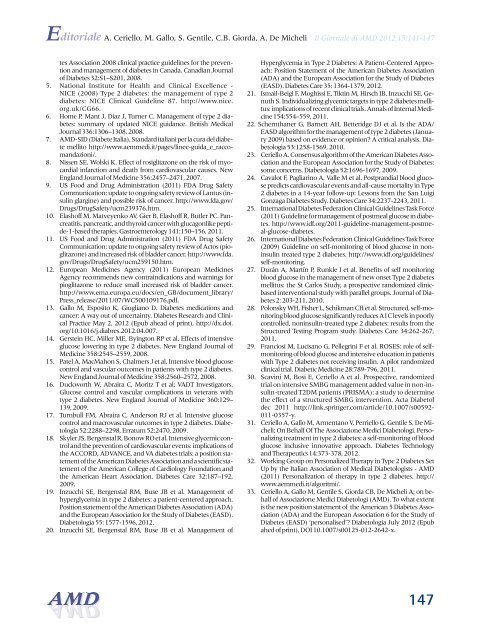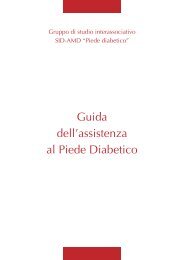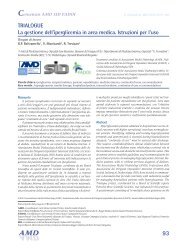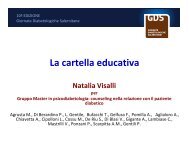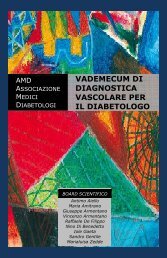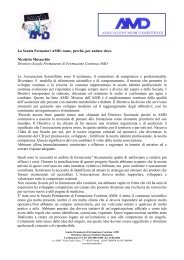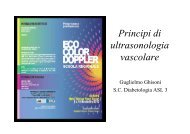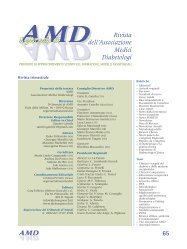Numero 3, Volume 15 - luglio 2012 - Nuova Serie - AMD
Numero 3, Volume 15 - luglio 2012 - Nuova Serie - AMD
Numero 3, Volume 15 - luglio 2012 - Nuova Serie - AMD
Create successful ePaper yourself
Turn your PDF publications into a flip-book with our unique Google optimized e-Paper software.
Editoriale A. Ceriello, M. Gallo, S. Gentile, C.B. Giorda, A. De Micheli<br />
tes Association 2008 clinical practice guidelines for the prevention<br />
and management of diabetes in Canada. Canadian Journal<br />
of Diabetes 32:S1–S201, 2008.<br />
5. National Institute for Health and Clinical Excellence -<br />
NICE (2008) Type 2 diabetes: the management of type 2<br />
diabetes: NICE Clinical Guideline 87. http://www.nice.<br />
org.uk/CG66.<br />
6. Home P, Mant J, Diaz J, Turner C. Management of type 2 diabetes:<br />
summary of updated NICE guidance. British Medical<br />
Journal 336:1306–1308, 2008.<br />
7. <strong>AMD</strong>-SID (Diabete Italia), Standard italiani per la cura del diabete<br />
mellito http://www.aemmedi.it/pages/linee-guida_e_raccomandazioni/.<br />
8. Nissen SE, Wolski K. Effect of rosiglitazone on the risk of myocardial<br />
infarction and death from cardiovascular causes. New<br />
England Journal of Medicine 356:2457–2471, 2007.<br />
9. US Food and Drug Administration (2011) FDA Drug Safety<br />
Communication: update to ongoing safety review of Lantus (insulin<br />
glargine) and possible risk of cancer. http://www.fda.gov/<br />
Drugs/DrugSafety/ucm239376.htm.<br />
10. Elashoff M, Matveyenko AV, Gier B, Elashoff R, Butler PC. Pancreatitis,<br />
pancreatic, and thyroid cancer with glucagonlike peptide-1-based<br />
therapies. Gastroenterology 141:<strong>15</strong>0–<strong>15</strong>6, 2011.<br />
11. US Food and Drug Administration (2011) FDA Drug Safety<br />
Communication: update to ongoing safety review of Actos (pioglitazone)<br />
and increased risk of bladder cancer. http://www.fda.<br />
gov/Drugs/DrugSafety/ucm259<strong>15</strong>0.htm.<br />
12. European Medicines Agency (2011) European Medicines<br />
Agency recommends new contraindications and warnings for<br />
pioglitazone to reduce small increased risk of bladder cancer.<br />
http://www.ema.europa.eu/docs/en_GB/document_library/<br />
Press_release/2011/07/WC500109176.pdf.<br />
13. Gallo M, Esposito K, Giugliano D. Diabetes medications and<br />
cancer: A way out of uncertainty. Diabetes Research and Clinical<br />
Practice May 2, <strong>2012</strong> (Epub ahead of print), http://dx.doi.<br />
org/10.1016/j.diabres.<strong>2012</strong>.04.007.<br />
14. Gerstein HC, Miller ME, Byington RP et al. Effects of intensive<br />
glucose lowering in type 2 diabetes. New England Journal of<br />
Medicine 358:2545–2559, 2008.<br />
<strong>15</strong>. Patel A, MacMahon S, Chalmers J et al. Intensive blood glucose<br />
control and vascular outcomes in patients with type 2 diabetes.<br />
New England Journal of Medicine 358:2560–2572, 2008.<br />
16. Duckworth W, Abraira C, Moritz T et al; VADT Investigators.<br />
Glucose control and vascular complications in veterans with<br />
type 2 diabetes. New England Journal of Medicine 360:129–<br />
139, 2009.<br />
17. Turnbull FM, Abraira C, Anderson RJ et al. Intensive glucose<br />
control and macrovascular outcomes in type 2 diabetes. Diabetologia<br />
52:2288–2298, Erratum 52:2470, 2009.<br />
18. Skyler JS, Bergenstal R, Bonow RO et al. Intensive glycemic control<br />
and the prevention of cardiovascular events: implications of<br />
the ACCORD, ADVANCE, and VA diabetes trials: a position statement<br />
of the American Diabetes Association and a scientific statement<br />
of the American College of Cardiology Foundation and<br />
the American Heart Association. Diabetes Care 32:187–192,<br />
2009.<br />
19. Inzucchi SE, Bergenstal RM, Buse JB et al. Management of<br />
hyperglycemia in type 2 diabetes: a patient-centered approach.<br />
Position statement of the American Diabetes Association (ADA)<br />
and the European Association for the Study of Diabetes (EASD).<br />
Diabetologia 55: <strong>15</strong>77-<strong>15</strong>96, <strong>2012</strong>.<br />
20. Inzucchi SE, Bergenstal RM, Buse JB et al. Management of<br />
<strong>AMD</strong><br />
Il Giornale di <strong>AMD</strong> <strong>2012</strong>;<strong>15</strong>:141-147<br />
Hyperglycemia in Type 2 Diabetes: A Patient-Centered Approach:<br />
Position Statement of the American Diabetes Association<br />
(ADA) and the European Association for the Study of Diabetes<br />
(EASD). Diabetes Care 35: 1364-1379, <strong>2012</strong>.<br />
21. Ismail-Beigi F, Moghissi E, Tiktin M, Hirsch IB, Inzucchi SE, Genuth<br />
S. Individualizing glycemic targets in type 2 diabetes mellitus:<br />
implications of recent clinical trials. Annals of Internal Medicine<br />
<strong>15</strong>4:554–559, 2011.<br />
22. Schernthaner G, Barnett AH, Betteridge DJ et al. Is the ADA/<br />
EASD algorithm for the management of type 2 diabetes (January<br />
2009) based on evidence or opinion? A critical analysis. Diabetologia<br />
53:1258-<strong>15</strong>69, 2010.<br />
23. Ceriello A. Consensus algorithm of the American Diabetes Association<br />
and the European Association for the Study of Diabetes:<br />
some concerns. Diabetologia 52:1696-1697, 2009.<br />
24. Cavalot F, Pagliarino A, Valle M et al. Postprandial blood glucose<br />
predicts cardiovascular events and all-cause mortality in Type<br />
2 diabetes in a 14-year follow-up: Lessons from the San Luigi<br />
Gonzaga Diabetes Study. Diabetes Care 34:2237-2243, 2011.<br />
25. International Diabetes Federation Clinical Guidelines Task Force<br />
(2011) Guideline for management of postmeal glucose in diabetes.http://www.idf.org/2011-guideline-management-postmeal-glucose-diabetes.<br />
26. International Diabetes Federation Clinical Guidelines Task Force<br />
(2009) Guideline on self-monitoring of blood glucose in noninsulin<br />
treated type 2 diabetes. http://www.idf.org/guidelines/<br />
self-monitoring.<br />
27. Durán A, Martín P, Runkle I et al. Benefits of self monitoring<br />
blood glucose in the management of new onset Type 2 diabetes<br />
mellitus: the St Carlos Study, a prospective randomized clinicbased<br />
interventional study with parallel groups. Journal of Diabetes<br />
2: 203-211, 2010.<br />
28. Polonsky WH, Fisher L, Schikman CH et al. Structured, self-monitoring<br />
blood glucose significantly reduces A1C levels in poorly<br />
controlled, noninsulin-treated type 2 diabetes: results from the<br />
Structured Testing Program study. Diabetes Care 34:262-267,<br />
2011.<br />
29. Franciosi M, Lucisano G, Pellegrini F et al. ROSES: role of selfmonitoring<br />
of blood glucose and intensive education in patients<br />
with Type 2 diabetes not receiving insulin. A pilot randomized<br />
clinical trial. Diabetic Medicine 28:789-796, 2011.<br />
30. Scavini M, Bosi E, Ceriello A et al. Prospective, randomized<br />
trial on intensive SMBG management added value in non-insulin-treated<br />
T2DM patients (PRISMA): a study to determine<br />
the effect of a structured SMBG intervention. Acta Diabetol<br />
dec 2011 http://link.springer.com/article/10.1007/s00592-<br />
011-0357-y.<br />
31. Ceriello A, Gallo M, Armentano V, Perriello G, Gentile S, De Micheli;<br />
On Behalf Of The Associazione Medici Diabetologi. Personalizing<br />
treatment in type 2 diabetes: a self-monitoring of blood<br />
glucose inclusive innovative approach. Diabetes Technology<br />
and Therapeutics 14:373-378, <strong>2012</strong>.<br />
32. Working Group on Personalized Therapy in Type 2 Diabetes Set<br />
Up by the Italian Association of Medical Diabetologists - <strong>AMD</strong><br />
(2011) Personalization of therapy in type 2 diabetes. http://<br />
www.aemmedi.it/algoritmi/.<br />
33. Ceriello A, Gallo M, Gentile S, Giorda CB, De Micheli A; on behalf<br />
of Associazione Medici Diabetologi (<strong>AMD</strong>). To what extent<br />
is the new position statement of the American 5 Diabetes Association<br />
(ADA) and the European Association 6 for the Study of<br />
Diabetes (EASD) ‘personalised’? Diabetologia July <strong>2012</strong> (Epub<br />
ahed of print), DOI 10.1007/s00125-012-2642-x.<br />
147


